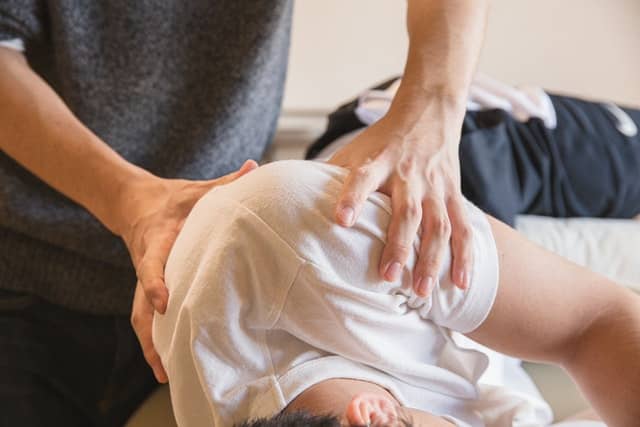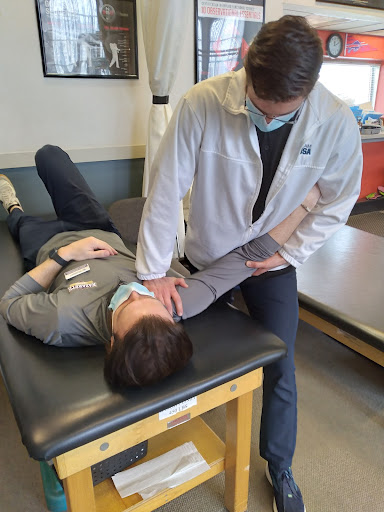The Peak Performance team are experts at shoulder physical therapy. Our extensive biomechanical training in Applied Functional Science © at the Gray Institute is critical in helping us understand and assess shoulder function so we can help those suffering from pain and limited function.
The shoulder is made up of actually three bones – the shoulder blade (scapula), collarbone (clavicle), and the arm bone (humerus). The “cup” of the scapula is very shallow, allowing for a large range of motion but also then requiring strong contributions of the muscles along with the ligaments and cartilage rim (labrum) for stability. There are 17 muscles alone that attach on just the scapula itself, connecting to the humerus, the ribs, the clavicle, the neck/skull, and the midback (thoracic spine).
The shoulder is a critical joint because it allows for use of our hands in day-to-day, work, and recreational activities. Its only strong ligamentous attachment to our actual body is through the acromioclavicular (AC) joint where the clavicle meets the scapula at the outer top part of your shoulder (note the small bump – end of the clavicle). The shoulder blade is otherwise only held to your body by muscles so the function of these is key to allowing full use of the arm and hand. The nerves from our neck and back also pass through the shoulder to feed our entire upper extremity into the hand. There are numerous places shoulders can develop dysfunction and become painful.
Shoulders must be able to reach, throw, push, pull, rotate, accept leaning loads…etc. It is our most mobile joint and is often injured due to both traumatic injuries and also overuse.
Acute injuries can happen – sudden moments where you know something just went wrong. Those tend to be injuries to the ligaments (“sprains” ), to the joint – slipping too far (subluxations and dislocations), to the cartilage rim(labral tears), to the bones (fractures), or to the muscle-tendon’s (strains)- tears) usually to the rotator cuff or biceps tendon.

More chronic type pains often are the result of what we call microstresses over time or overuse injuries… smaller overloads that are usually less perceptible or imperceptible, that end up causing “wear and tear” type damage and injury. Those are often things like arthritis, tendonitis/impingement, bursitis, frozen shoulder, scapular winging, or thoracic outlet syndrome type conditions.
No matter what the injury, shoulder problems can put a big dent in not only your comfort levels but your ability to live the life you want. It can mean not being able to work or play sports, to not work out, or even being unable to do even simple daily activities like walking or climbing stairs or twisting to reach for something. For some, it can produce a real fear of an inevitable feeling that the injury or pain could get worse.
If you’re spending more than just a few days or a week with some soreness or limitations that aren’t going away it makes sense to get your problem addressed. It almost always takes less time to recover, less effort on your part, and fewer costs when you get the treatments you need sooner than later!
You can read more about common shoulder injuries below. Whether this sounds like something you may have going on or your details seem a bit different, the team of orthopedic and sports PT experts at Peak Performance are ready to help you get back to being comfortable, capable, and confident again!
Common Types of Shoulder Injuries

- Rotator Cuff Tendonitis/Shoulder Impingement. The four rotator cuff tendons attach the arm (humerus) to the scapula. The supraspinatus on top is the most commonly injured tendon. A sudden trauma like too hard a throw or a fall can strain the tendons but more commonly long-term overuse leads to inflammation and then wear and tear type stresses on the tendon(s). Usually, this results in pain in raising the arm, difficulty sleeping, and reduced daily activity. Impingement is specifically a condition where abnormal anatomy of the shoulder bones, abnormal mechanics due to weakness and/or tightness, or instability of the ligaments can cause pinching stresses to the tendons during functional use of the arm.
- Rotator Cuff Tears. Sudden high forces or overloads can cause tears in the rotator cuff (RC) tendons. This may occur from a fall or unexpected forceful motion. Tears can be partial or full/complete. Full traumatic tears, especially in people under 40-50 yrs old often require surgery. Degenerative tears also occur – the result of microtrauma stresses over time that causes breakdown and weakening of the tendon. Studies show that many degenerative tear injuries can be successfully rehabbed when nearly full overhead motion is still available. One key consideration for the orthopedic surgeon will be whether the tear can still be mobilized (brought together) for repair. If non-operative care is not very successful early on then surgery may be necessary. Post-operative therapy is essential to a successful recovery after surgery, helping patients through the high protection phase early on and then progress safely with exercises and return to activity phases later on.
- Labral Tears. The cartilage rim surrounding the cup of the shoulder (glenoid) can be torn both acutely with high forces or over time with degenerative changes. Sharp pains are often felt along with significant snapping or clunking of the shoulder, especially in overhead or cross-body activities. Depending on the severity and activity goals these can often be treated non-operatively however surgery to debride (trim away) or repair the labrum may be necessary. Similar to RC repairs the post-operative therapy done is essential to recovery.
- Frozen Shoulder (AKA “Adhesive capsulitis”). The main shoulder joint (glenohumeral) where the arm bone meets the shoulder blade, is surrounded by ligament tissue called the joint capsule. Local shoulder injury and pain, such as a fracture or bad tendonitis, but even sometimes other issues in the arm or hand (especially for menopausal years females and/or those with diabetes) can trigger a scarring response of the shoulder capsule that progresses from high pain levels to progressive loss of motion and eventually less pain with greatly restricted mobility. Hands-on manual therapy and customized stretching are key aspects of proper care here.
- Shoulder Arthritis. Shoulder osteoarthritis (OA) or degenerative joint disease (DJD) is the most common type at the shoulder. It is an over-time wear and tear-based thinning of the cartilage that coats the bone ends, resulting in pain, stiffness, and loss of motion, and inability to use the upper extremity normally. Often there are creaking or joint noises(crepitus) associated with more significant arthritis. Therapy can be a very effective treatment especially when addressed in earlier stages. With very severe OA a joint replacement may be necessary to resolve pain and improve function.
- Shoulder Instability, Subluxation, and Dislocation. Acute overloads especially into extremes of throwing-type motions (falls, external forces such as an opponent) can cause the humeral head to move outside its normal boundaries of the “cup” (really more like a saucer) of the shoulder blade. Small slips are termed subluxations but a dislocation can occur where the entire ball or head of the humerus slides beyond the border of the shoulder blade (glenoid) where it normally is positioned. This occurs as ligaments are overstretched/torn and the labrum is disrupted also. Full dislocations usually require medical attention to reduce the bone back into place.
How Physical Therapy Helps Shoulder Injuries
Our Peak Performance shoulder care program starts with understanding the anatomy and biomechanics of the shoulder itself but very importantly also includes an assessment of its “next-door neighbors”, the neck above and the thoracic spine and even hips below.
Our functional biomechanics training from the Gray Institute allows us to test for key contributing factors that may have caused your shoulder to become overstressed by compensating for shortcomings elsewhere. Too often patients and even health care professionals have a “you’re a bad shoulder” sort of mindset. That results in focusing too exclusively on the shoulder and ignoring or mistaking which other areas actually need help.
There are common themes underlying or affecting the recovery of many shoulder conditions above. Some key areas that need to be evaluated beyond simple mobility and strength measures of the actual shoulder include thoracic spine motion, pectoralis minor tightness affecting the shoulder blade, serratus anterior weakness reducing shoulder blade stability and tightness affecting the back of the rotator cuff and capsule.
Remember, it’s critical to find and treat the causes also and not just the symptoms, otherwise, your pains are likely to recur.
We Proudly Offer Shoulder Physical Therapy in Rochester, NY
At Peak Performance, our expert therapists are driven by a passion to help people resolve their pain and restore their function.
Getting you back to what you love doing is what motivates us. That’s fueled by our extensive training in Applied Functional Science © that helps us identify shortcomings in other areas (often missed or neglected by traditional therapy) that either may have contributed to your problem or could be the cause of a slow recovery.
We’d be honored to help you get back to being you again! Call us today to get a shoulder evaluation and begin your road to recovery.










